|
Information
Service of
the Serbian Orthodox Church
December 2, 2004

CELEBRATION
OF 600 YEAR ANNIVERSARY
OF MOUNTING OF CLOCK IN MOSCOW
IN 1404 CONSTRUCTED BY SERBIAN MONK LAZAR
OF CHILANDAR
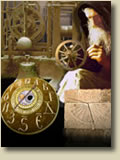 Since
Lazar (Lazarus) the Serb was a monk of Chilandar Monastery on
Holy Mt. Athos, and the patronal feast of Chilandar Monastery
is the Entry of the Most Holy Theotokos into the Temple, the organizational
committee for the commemoration of the six hundred year anniversary
of the mounting of the clock in Moscow agreed to hold the ceremony
on the same date, i.e. on Saturday, December 4, 2004. Since
Lazar (Lazarus) the Serb was a monk of Chilandar Monastery on
Holy Mt. Athos, and the patronal feast of Chilandar Monastery
is the Entry of the Most Holy Theotokos into the Temple, the organizational
committee for the commemoration of the six hundred year anniversary
of the mounting of the clock in Moscow agreed to hold the ceremony
on the same date, i.e. on Saturday, December 4, 2004.
On the Feast
of the Entry into the Temple on December 4 during Liturgy in the
churches of Belgrade, in Moscow where the clock was mounted, as
well as in Chilandar Monastery on Holy Mt. Athos from where monk
Lazar set out and Holy Archangels Monastery in Prizren from where
he is thought to have originated, mention will be made of “Monk
Lazar the Serb”, the name by which he is known in all documents.
At noon on December 4, 2004 a sundial will be consecrated on the
old building of the Theological Faculty of the Serbian Orthodox
Church, in Zadarska Street in Belgrade. The sundial was constructed
Dr. Milutin Tadic and decorated with frescoes by students of the
Serbian Orthodox Church Academy.
As part of
the celebration of the six hundred year anniversary of the mounting
of the first striking clock in the Kremlin constructed by monk
Lazar (Lazarus) the Serb from Holy Mount Athos, on Saturday, December
4, 2004 on the Feast of the Entry of the Most Holy Theotokos into
the Temple, at 7:00 p.m. an exhibition of icons by the students
of the Serbian Orthodox Church’s Academy for Fresco Painting and
Restoration under the mentorship of fresco painting instructor
Goran Janicijevic will open in Belgrade.
On the same
evening a roundtable discussion will take place at 7:00 p.m. in
the Russian Hall in Belgrade on the theme of “Six hundred year
anniversary of the construction of the clock in the Kremlin by
Monk Lazar Crnorizac”. An exhibition of icons by the students
of the Serbian Orthodox Church’s Academy will be opened in the
Hall with the participation of a choir of students from St. Sava
Seminary and video presentations.
The facilitator
of the roundtable will be Professor Dr. Predrag Ristic, architect.
Participants in the discussion will include Dr. Anika Skovran
(“Serbs and Russians in the Middle Ages”), archeologist Gordana
Tosic, Professor Dr. Milutin Tadic (“From the Studenica clock
to the clock of Lazar”), Engineer Zelimir Stefanovic (“Development
of mechanical clocks and work on their reconstruction”), architect
Gordana Markovic, the director of the Serbian Institute for the
Protection of Cultural Monuments (“Program for investigating the
mission of Lazar the Serb”). Vladan Zdravkovic will use video
presentations to show the reconstruction of Belgrade Fortress
with its domes and clocks.
In
1404 Grand Duke Vasily Dimitriyevich commissioned a Serbian monk
from Mount Athos to build the first striking clock in the Kremlin.
According to the Chronicle the clock did not have figures but
letters written on the rim, which turned around instead of hands.
Lazar was the inventive monk, who also constructed a bell and
a mechanical map for the clock. Each hour on the hour the rim
moved one twelfth of the semi-circle and the mechanical man hit
the bell with the hammer that he held in his hands. There were
daily and night hours, the first beginning with the sunrise, and
the hours of sunrise and sunset were rest each fortnight. The
clock was a great wonder to Muscovites, who could not understand
how the mechanical man could be so precise, and do his job without
being told or pushed by anybody. Then it was agreed that the gadget
was "somehow the product of man's dexterity and governed
by his wits." Before he left Moscow, Lazar trained a Russian
watchmaker to service the clock and twice a month to make the
necessary time adjustments.

NJEGOS
ENDOWMENT FOR SERBIAN STUDIES AT COLUMBIA UNIVERSITY MARKS BICENTENNIAL
OF FIRST SERBIAN UPRISING
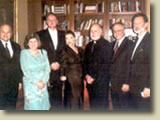 The
Njegos Endowment for Serbian Studies at Columbia University held
its most important event this year on November 13, to commemorate
the anniversary of the First Serbian Uprising and 200 years of
an independent Serbian state. The commemoration began with a scholarly
symposium entitled: The 1804 Serbian Uprising - Political, Social
and Cultural Legacies. Speakers were Dusan Batakovic, Ambassador
of Serbia and Montenegro to Athens; Dimitrije Djordjevic, Professor
Emeritus at the University of California, Santa Barbara; Thomas
Emmert, Gustavus Adolphus College; Joel Halpern, Professor Emeritus
at the University of Massachusetts, Amherst; Gale Stokes, Rice
University; Veljko Vujacic, Oberlin College; and Radmila J. Gorup,
Columbia University. The panels were chaired by Roger Peterson,
Massachusetts Institute of Technology; and Slobodan Curcic, Princeton
University. The
Njegos Endowment for Serbian Studies at Columbia University held
its most important event this year on November 13, to commemorate
the anniversary of the First Serbian Uprising and 200 years of
an independent Serbian state. The commemoration began with a scholarly
symposium entitled: The 1804 Serbian Uprising - Political, Social
and Cultural Legacies. Speakers were Dusan Batakovic, Ambassador
of Serbia and Montenegro to Athens; Dimitrije Djordjevic, Professor
Emeritus at the University of California, Santa Barbara; Thomas
Emmert, Gustavus Adolphus College; Joel Halpern, Professor Emeritus
at the University of Massachusetts, Amherst; Gale Stokes, Rice
University; Veljko Vujacic, Oberlin College; and Radmila J. Gorup,
Columbia University. The panels were chaired by Roger Peterson,
Massachusetts Institute of Technology; and Slobodan Curcic, Princeton
University.
 That
same evening, a beautiful gala dinner was held at the prestigious
Princeton-Columbia Club in midtown Manhattan. Distinguished guests
from both Serbia and Montenegro and the Diaspora were invited.
Special guest of honor was H.R.H. Princess Elizabeth Karadjordjevic.
The Master of Ceremonies was Fr. Irinej Dobrijevic, and the musical
talents of Marina Arsenijevic, world acclaimed pianist, highlighted
the evening. Fr. Irinej, on behalf of the Information Service
of the Serbian Orthodox Church, presented a gift of gold commemorative
coins issued by the Holy Synod of Bishops of the Serbian Orthodox
Church, to mark the 200th Anniversary of the Uprising, to Professor
Gorup and Gordon M. Bardos, Assistant Director of the Harriman
Institute, in recognition of their work for the Njegos Endowment. That
same evening, a beautiful gala dinner was held at the prestigious
Princeton-Columbia Club in midtown Manhattan. Distinguished guests
from both Serbia and Montenegro and the Diaspora were invited.
Special guest of honor was H.R.H. Princess Elizabeth Karadjordjevic.
The Master of Ceremonies was Fr. Irinej Dobrijevic, and the musical
talents of Marina Arsenijevic, world acclaimed pianist, highlighted
the evening. Fr. Irinej, on behalf of the Information Service
of the Serbian Orthodox Church, presented a gift of gold commemorative
coins issued by the Holy Synod of Bishops of the Serbian Orthodox
Church, to mark the 200th Anniversary of the Uprising, to Professor
Gorup and Gordon M. Bardos, Assistant Director of the Harriman
Institute, in recognition of their work for the Njegos Endowment.
This
proud and inspiring heritage of 1804 is being upheld at Columbia
University through the Njegos Endowment for Serbian Studies. Established
in 1996 with the goal of establishing an endowed chair in the
Serbian language at Columbia University. For more information
on the Njegos Endowment and its programs, please visit the Njegos
Endowment website at:
http://www.columbia.edu/cu/sipa/REGIONAL/ECE/serbian.html

TRANSFORMED
ETHOS:
ART AND ARCHITECTURE IN KOSOVO AND METOHIJA
Hieromonk
Irinej Dobrijevic was among the participants at the thirtieth
annual Byzantine Studies Conference held under the auspices of
Dumbarton Oaks of the Harvard University Center for Byzantine
Studies on October 29, 2004 in the Walters Art Museum in Baltimore,
Maryland, U.S.A. Fr. Dobrijevic spoke during the afternoon session
on the subject of “Transformed ethos: Art and architecture in
Kosovo and Metohija”.
As
a witness of the destroyed churches and monasteries in Kosovo
and Metohija, Fr. Irinej’s presentation was a vivid account of
terrorist attacks on Orthodox shrines in Kosovo and Metohija,
and well received by the gathered byzantologists. After the well-attended
lecture, Fr. Irinej proposed to the group that the Byzantine Studies
Conference undertake the restoration of the destroyed medieval
church of Bogorodica Ljeviska (the Holy Virgin of Lyevish) in
Prizren.

CARDINAL
ANTONELLI VISITS ST. SAVA ELEMENTARY SCHOOL
IN MLADENOVAC
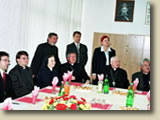 On
Tuesday, November 30, 2004 Monsignor Ennio Antonelli, Archbishop
of Florence, Italy, Monsignor Stanislav Hocevar, Archbishop of
Belgrade, Don Pedro Sabattini and Sister Ines visited St. Sava
Elementary School in Mladenovac. The guests were received on behalf
of His Grace Bishop Jovan of Sumadija by Protopresbyter-Stavrophor
Dragoljub Rakic, the hierarchal administrator for Mladenovac,
and Deacon Petar Leskovac, teacher of religion. On
Tuesday, November 30, 2004 Monsignor Ennio Antonelli, Archbishop
of Florence, Italy, Monsignor Stanislav Hocevar, Archbishop of
Belgrade, Don Pedro Sabattini and Sister Ines visited St. Sava
Elementary School in Mladenovac. The guests were received on behalf
of His Grace Bishop Jovan of Sumadija by Protopresbyter-Stavrophor
Dragoljub Rakic, the hierarchal administrator for Mladenovac,
and Deacon Petar Leskovac, teacher of religion.
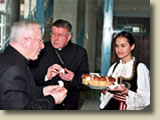 The
high officials were greeted by Fr. Dragoljub and the president
of the Mladenovac municipal assembly, Mr. Zoran Kostic. After
a traditional welcome with bread and salt, the director of St.
Sava Elementary School, Nadezda Manic, expressed her sincere thanks
for the gift presented by the guests to the school. In his address
Cardinal Ennio responded to the warm words of welcome and emphasized
that, as a former teacher, he is familiar with the work of schools
and very pleased that cooperation between Florence and Mladenovac
is unfolding through St. Sava Elementary School. The Cardinal
mentioned that he had also visited the Russian Patriarch in Moscow,
the Romanian Patriarch in Bucharest, and Serbian Patriarch Pavle
in Belgrade. These were wonderful meetings, the Cardinal said,
emphasizing that the Serbian Patriarch was a strongly spiritual
man, a man of prayer. The
high officials were greeted by Fr. Dragoljub and the president
of the Mladenovac municipal assembly, Mr. Zoran Kostic. After
a traditional welcome with bread and salt, the director of St.
Sava Elementary School, Nadezda Manic, expressed her sincere thanks
for the gift presented by the guests to the school. In his address
Cardinal Ennio responded to the warm words of welcome and emphasized
that, as a former teacher, he is familiar with the work of schools
and very pleased that cooperation between Florence and Mladenovac
is unfolding through St. Sava Elementary School. The Cardinal
mentioned that he had also visited the Russian Patriarch in Moscow,
the Romanian Patriarch in Bucharest, and Serbian Patriarch Pavle
in Belgrade. These were wonderful meetings, the Cardinal said,
emphasizing that the Serbian Patriarch was a strongly spiritual
man, a man of prayer.
Icon
painter Dejan Mandel, the owner of the icon-painting workshop
Znamenje, presented His Eminence with an icon.

ORTHODOX
RELIGIOUS INSTRUCTION IN AUSTRIA
IN ITS SCHOOL-CHURCH-LEGAL CONTEXT
An
article by Branislav Djukaric presenting historical information
regarding legislative and legal measures relevant to religious
instruction in Austria is available and can be downloaded in .doc
format (in Serbian only) at:
http://www.spc.org.yu/Vesti-2004/12/austrija.doc

[Serbian
Translation Services]
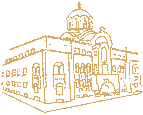
Copyright © 1999-2004 by
The Information Service of
the Serbian Orthodox Church
11000 Belgrade
Kralja Petra I no.5
+381 11 3282 596
e-mail
|

